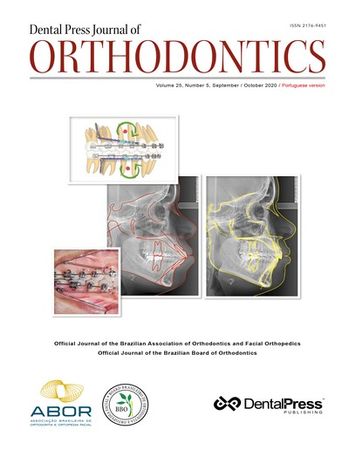
Seu carrinho está vazio!
Introduction: Nasal septum deviation (NSD) is the most common structural cause of nasal obstruction, affecting around 65-80% of the adult population. Rapid maxillary expansion (RME) is currently used for treatment of maxillary transverse deficiency, but can also influence nasal cavity geometry. Objective: The present study aimed at evaluating the changes in NSD by using Cone-Beam Computed Tomography (CBCT) scans in pre-pubertal patients treated with RME. Methods: This retrospective...


Upon concluding a lecture on dentoalveolar bimaxillary protrusions and their treatment possibilities, I was asked many questions about the association between the reduction in the volume of dental arches after extractions and the development of respiratory disorders, notably obstructive sleep apnea (OSA). I admit that at that time I was not aware of the current evidence on the correlation between these two factors, which led me to question whether Orthodontics was causing OSA by retracting...

Orthodontic patients often describe an feeling of discomfort or pain associated with certain orthodontic procedures, such as placing elastic separators, replacement of orthodontic archwires and activation of appliances. Because of this, the use of painkillers by patients is not novelty. However, since such drugs can affect the biochemical process involved in the orthodontic dental movement, a comprehensive understanding of its effects is necessary. There is an infinity of studies that...

Introduction: The dental pulp is completely normal in teeth with periapical cemento-osseous dysplasia. However, orthodontic and endodontic treatments are contraindicated in cases with this injury. Objective: Present some biological, clinical and imaging reasons opposing these contraindications and questioning which are the real ones impediments and the reasons for the lack of research on the disease, analyzing cases submitted to orthopedic treatment under controlled and ethically approved...

Introduction: For dental professionals, including orthodontists, Quality of life (QOL) is a topic of growing concern and could be determined by objective and subjective complex factors. Objective: This study analyzed the factors that influence the QOL of orthodontists graduated between 1993 and 2016 of a public university (Medellín, Colombia). Methods: A mixed-methods study was conducted (cross-sectional survey; 88 participants; 3 focus groups, 21 participants). Quantitative analysis: the...

Objective: The present study aimed at comparing the external lateral root resorption (ELRR) and external apical root resorption (EARR) between teeth moved through the atrophic edentulous ridge and those undergoing the usual orthodontic movement. Methods: Fifty-four premolars were evaluated, where 27 of them had been moved toward the edentulous ridge (Group 1) and 27 from the same patient, had not been translated, which comprised the control group (Group 2). ELRR was evaluated by 0-3 scores and...

Objective: This prospective study aimed at assessing the effects of anxiety and a follow-up text message on pain perception after the installation of fixed orthodontic appliances and its impact on the patients’ routine. Methods: The sample of this study consisted of 103 orthodontic patients, 40 males and 63 females (mean age 20.5 years), distributed in two groups: G1 (n=51), including control patients that did not receive any post-procedure communication; and G2 (n=52), including patients...

Objective: To evaluate a protocol for bonding metallic brackets after bleaching with hydrogen peroxide (HP). Methods: 60 extracted maxillary premolar were randomly divided into an unbleached control group and two groups bleached with a solution of 35% hydrogen peroxide prior to bonding. The teeth in one of the treated groups were bonded immediately after bleaching; while the other group was treated with 10% sodium ascorbate immediately after bleaching and before bonding. The teeth in all groups...

Introduction: The most prescribed treatment option for Obstructive Sleep Apnea (OSA) is CPAP; however, its adherence is limited. Oral Appliance therapy (OAT) is frequently an option or even an adjuvant, being the mandibular advancement Oral Appliance (OAm) the most used prescription. It modifies the upper airway, improving the airway patency. OAm construction is based on the occlusal plane to disocclusion. In this study, the DIORS® appliance was used, a singular OAm, based on Neuro-...

Introduction: Supervising the development of occlusion, managing problems during the transition from mixed to permanent dentition, as well as controlling environmental factors that contribute to establishing malocclusion, are important actions to achieve a Class I occlusion with facial balance. Among these problems, the malocclusions associated with dysfunctions such as mouth breathing or obstructive sleep apnea syndrome (OSAS), atypical swallowing and abnormal tongue position, open bites,...

Introduction: Moderate and severe bimaxillary protrusion impair the passive lip sealing and the facial and smile esthetics. The extraction of premolars can be avoided by the use of skeletal anchorage to retract both dental arches. This approach brings many advantages such as: prevents premolars extraction; simplifies orthodontic mechanics; there is no volume reduction of a premolar when smiling; control of overbite and gingival exposure. The utilization of this therapeutic approach, when...

Copyright © 1998 - 2022 DentalGO | Todos Direitos Reservados. DentalGO é uma marca Dental Press